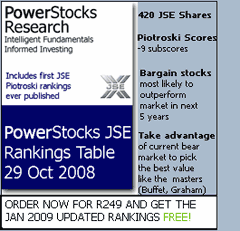
The above process, when conducted on the JSE on 28 April 2003 (bottom of last crash) resulted in 6 stocks being eventually highlighted from a total of 271, with these 6 stocks growing up to a staggering 1042% in the subsequent bull market (based on a portfolio constructed in proportion to these shares' market cap) or 593% (based on a portfolio constructed in equal 1/6th proportions per share).
The NAV and Piotroski screens on their own and combined were found to create less growth with portfolios constructed according to market-cap proportion, however PE, PriceFinder-a and especially ValueFinder showed much stronger growth using market cap based portfolio construction.
Note how ALL the 6 PowerStocks screens narrowed down the portfolio size and substantially outperformed the 350% growth of the ALSI Index, for BOTH portfolio construction methods. As the screens were used in combination, they significantly enhanced the performance achieved
Click here for a recap of the PE screen
Click here for a recap of the Price-to-Book screen
Click here for a recap of the PriceFinder-a screen
Click here for a recap of the Piotroski and PriceFinder-b screen
Click here for a recap of the ValueFinder screen
NEXT UP : Using our unique PowerStocks scoring system to increase above portfolio performance by 20% whist reducing portfolio sizes by 75%



















